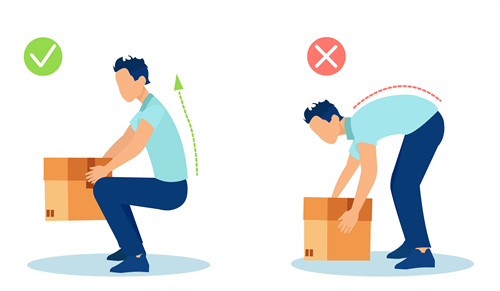
Safe lifting plays an important role in keeping your back healthy and you safe. Share these safe lifting techniques that take strain off the low back area.
- Look over the load. Decide if you can handle it alone or if you need assistance. When in doubt, ask for help. Moving an object that is too heavy or bulky can cause severe injury.
- Clear away any potential obstacles before beginning to carry the object.
- Support and propel the object while carrying it; your grip should be firm. Carrying objects will change your balance. To keep this change of balance to a minimum, keep the load close to your body and to your normal center of gravity, between the legs and shoulders.
- Use good foot positioning. Your feet should be shoulder width apart, with one foot beside and the other foot behind the object that you are going to lift. This allows you to use the full power of your leg muscles. Leg muscles are stronger and more powerful than back muscles, so let your legs do the work.
- Bend your knees. Bending over at the waist to reach for the object you want to lift puts strain on your back, shoulder and neck muscles.
- Keep your arms and elbows as close to your body as you can while lifting. If you have to stretch your arms out completely away from your body, ask for assistance with the lift.
- Use your feet to change direction. Don’t twist your body. Twisting your body adds to the stress of the lift and affects your balance.
- To lower the object, bend your knees as you did to pick it up. To place the load on a bench or shelf, set it on the edge and slide it into position. Make sure your hands and feet are clear when lowering the load.
Safe lifting of heavy objects requires training and practice. And when equipment is available, it should be used to lift and carry heavy objects. Loaders, forklifts and hoists are designed for this purpose.
Team Lifting
When others are helping you lift, teamwork is very important. If you’re going to be carrying the load to another location, both of you should coordinate this prior to lifting the object. Check the route and clearance. One worker needs to be able to observe and direct the other. Lifting and lowering should be done in unison. Don’t let the load drop suddenly without warning your partner.
Categorized in:
-
Transportation Safety
-
Health & Wellness
-
Injury Prevention
-
Workers Compensation
ClickToAddCategories
No categories have been created yet.
Community
Company Updates
Driver Recruitment
Investor News
Transportation Safety
Claims
Driver Management
Driving Techniques
Distracted Driving
Seasonal Driving Tips
Sharing the Road
Health & Wellness
Injury Prevention
Regulations
Security & Cargo Theft
Vehicle Inspections
Weather Conditions
Workplace Safety
Workers Compensation
Done